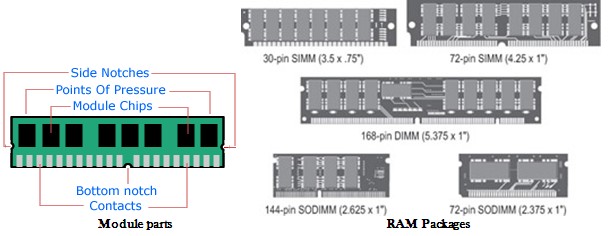Motherboard supports memory based on the speed of the front side bus (FSB) and the memory module’s form factor. So, if the motherboard’s FSB is 533MHz maximum, and 300 MHz rated memory is installed will make the computer operate slower. Thus, motherboards list which type(s) of memory they support and maximum speeds. The memory slots on a motherboard are designed for particular memory module form factors. The most popular form factors for primary memory modules today are
SIMM
A SIMM, or single in-line memory module, is a type of memory module containing random access memory used in computers from the early 1980s to the late 1990s.They were in two forms 30-pin SIMMs with capacities of 256 KB, 1 MB, 4 MB and maximum capacity was 16MB. 72-pin SIMMs with capacities of 1, 2,4,8,16,32, 64 MB and maximum capacity was 128 MB
DIMM
DIMM stands for Dual Inline Memory Module. DIMMs are 64-bit memory modules that are used as a package for SDRAM, DDR, and DDR2. Dual means the function of the pins on one side of the module from the corresponding pins on the other side. With 84 pins per side, this makes 168 independent pins on each standard memory module. The DIMM used for DDR memory has a total of 184 pins and a single keying notch, while the DIMM used for DDR2 has a total of 240 pins, one keying notch, and an aluminum cover for both sides.
RIMM
RIMM is a trademark of Rambus Inc. is a competing form factor to DIMM. It is a 16-bit or 32-bit
module. The 16-bit modules have 184 pins and two keying notches, while 32-bit modules have 232 pins and only one keying notch. Unique to the use of RIMM modules, a computer must have every RIMM slot occupied. Even one vacant slot will cause the computer not to boot.
SoDIMM
Notebook computers require much smaller components don’t use standard RAM packages like the SIMM or the DIMM do. Instead, they can use a much smaller memory form factor called a Small Outline DIMM (SoDIMM). SoDIMMs are available in many physical implementations, including the older 32-bit (72-pin) configuration and newer 64-bit (144-pin EDO, 144-pin SDRAM, and 200-pin DDR/DDR2) configurations.
MicroDIMM
The newest, and smallest, RAM form factor is the MicroDIMM. It is over 50 percent smaller than a SoDIMM, only 45.5 millimeters (about 1.75 inches) long and 30 millimeters (about 1.2 inches—a bit bigger than a quarter) wide. It was designed for the ultra light and portable computer. These modules have 144 pins or 172 pins and are similar to a DIMM in that they use a 64-bit data bus.

Apply for IT Support Certification
https://www.vskills.in/certification/certified-it-support-professional

